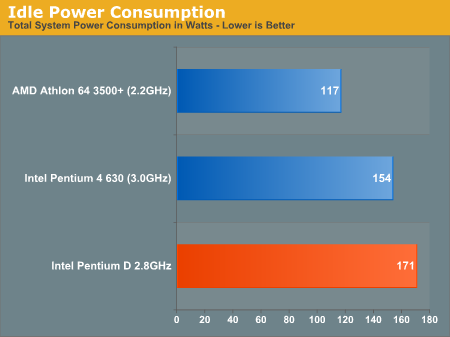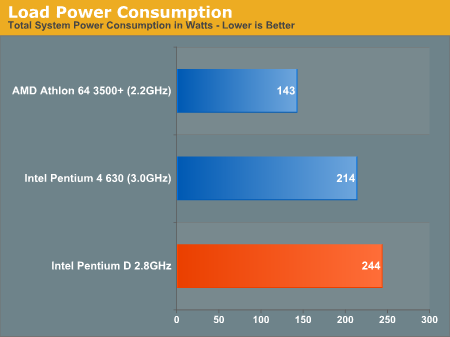Intel Dual Core Performance Preview Part II: A Deeper Look
by Anand Lal Shimpi on April 6, 2005 12:23 PM EST- Posted in
- CPUs
I'll admit, dual core has me excited for many of the reasons outlined in Part I. A big part is that personally, I've been using multiprocessor systems in my main computer for years. I've always appreciated the benefits of multiprocessor platforms, but recommending one for a desktop user has never been really feasible. Even the cheapest 2P workstation motherboards were at least twice the price of a desktop motherboard, not to mention the cost of the CPUs. The mass market had a short affair with multiprocessing in the days of the ABIT BP6 and the Celeron 300A, but in the grand scheme of things, that was barely a blip on the radar. Now, for the first time, both AMD and Intel are ready to bring the type of robustness of multiprocessor platforms to the desktop with their dual core offerings.
Part I focused on what dual core can offer, but now it's time for a much more practical look. We've never recommended Intel's Extreme Edition line of processors nor AMD's FX series, both supposedly marketed to gamers, but not purchased by any of our gaming readers. The processors that we recommend are usually much better values for the price, and thus, today's comparison isn't based around the most expensive dual core offerings, but rather the cheapest.
A point we made in the first article was that Intel's pricing strategy for dual core is extremely aggressive, with the cheapest 2.8GHz Pentium D soon to be introduced at $241. The problem is that at only 2.8GHz, the Pentium D won't have the strongest single threaded performance, which puts buyers in a sticky situation - do you buy an Athlon 64 3500+ for great single threaded performance or will the Pentium D give you a better overall multitasking experience? Intel doesn't do much to complicate the situation, as the Pentium D 2.8GHz will be close in price to the Pentium 4 630 (3.0GHz), which isn't much of a clock speed advantage. AMD will eventually have competitively priced dual core parts, but right now, AMD doesn't appear to be looking at the mainstream desktop market for dual core Athlon 64 chips.
The three chips mentioned above are the basis of the majority of today's comparison, but the decision is far from clear cut. Let's find out why.
Power Consumption
We'll start with power consumption - the contenders? A 90nm Athlon 64 3500+ vs. the Pentium 4 630 and the dual core 2.8GHz Pentium D. As always, we measured total system power at two states: idle and under a full load. For our full load test, we used a multithreaded application, 3ds max 7, performing the CBALLS2 render test from the SPECapc benchmark.


The K8 architecture simply lends itself to lower power consumptions than Intel's high frequency approach to computing with the Pentium 4 (especially Prescott). The move down to 90nm really reduced AMD's power consumption a lot, to the point where the 90nm Athlon 64 3500+ actually consumes less power under full load than the Pentium 4 630 at idle.
The Pentium 4 vs. Pentium D comparison is also interesting, as the 2nd core doesn't add all that much to overall system power consumption. In this case, we're looking at an increase in overall system power consumption by less than 15%. Intel still doesn't win in the power consumption department though; if you want something cool and quiet, AMD is still the way to go.
The Test
Our hardware configurations are similar to what we've used in previous comparisons.
AMD Athlon 64 Configuration
Socket-939 Athlon 64 CPUs
2 x 512MB OCZ PC3200 EL Dual Channel DIMMs 2-2-2-10
NVIDIA nForce4 Reference Motherboard
ATI Radeon X850 XT PCI Express
Intel Pentium 4 Configuration
LGA-775 Intel Pentium 4 and Extreme Edition CPUs
2 x 512MB Crucial DDR-II 533 Dual Channel DIMMs 3-2-2-12
Intel 955X Motherboard
ATI Radeon X850 XT PCI Express










106 Comments
View All Comments
mlittl3 - Wednesday, April 6, 2005 - link
Hey Anand,A really cool multitasking scenario for gaming would be running a game with something like Skype in the background. Everyone saying that a respectable gamer (whatever that means) would not run multi applications in the background is not thinking about VoIP.
I am in Louisiana and I like to game with my friend in Georgia. We talk to each other using Skype will playing Halo on the same server. I know the overhead necessary for VoIP must slow things down some.
Won't dual core help in this case?
Aikouka - Wednesday, April 6, 2005 - link
I know I personally have a lot of things open when gaming, especially if I'm playing World of Warcraft. I'll typically alt-tab out of the game to check IRC or Firefox (with a bunch of tabs open) to look something up or if I'm bored, just browse the net a little bit.The only problem I ever have with slowdowns is if the game is highly CPU-bound and uses up 100% of my CPU, which WoW does almost all the time.
Rand - Wednesday, April 6, 2005 - link
#10- I'm inclined to agree, but people did request it so presumably some people ar interested in doing so for whatever reason."I don´t close AVG and MS Antispyware and MSN and outlook and IExplorer everytime i open warcraft or half life 2, so...WHO MADE ME BELIEVE AMD WAS FASTER?"
Merely running applications in the background isn't going to do much to benefit DualCore/SMP unless those applications are actually utilizing the processor. Odds are MSN/Outlook/Spyware/Anti-virus probably aren't doing a thing but sitting idle when your gaming.
marcusgarcia - Wednesday, April 6, 2005 - link
#10: There surely is.I play warcraft III online, which is a RTS game.
Being so, not all actions are dependant on my reflex (in fact i can many times minimize the game for around 20 seconds which is the time my char takes to walk to a certain place on a given map).
That being said, i am ALWAYS with a few instances of internet explorer open, MSN open, outlook express open and of course AVG and MS Anti spyware loaded on memory with real time protection.
Add the fact that sometimes i am viewing and being viewed on MSN webcam.
I'm sure MANY more people do that.
Remember not all players are FPS gamers...in fact, FPS is far behind MMORPG in sales, which doesn't require near as much attention and reflex.
marcusgarcia - Wednesday, April 6, 2005 - link
OK.Something is very wrong here.
I mean, WHY DIDN'T ALL SITES DO THESE TESTS WHEN HT WAS LAUNCHED?
It clearly shows here what is MUCH better when it comes under regular usage.
A Pentium 4 3.0 ghz is beating AMD's trash on 3500+....i mean, WTF?
Almost noone (does anyone at all?) goes closing all applications before gaming or doing any other activity and HT is clearly giving AMD a serious beating on the multi-tasking scenario (read: EVERYONE's usage).
I don´t close AVG and MS Antispyware and MSN and outlook and IExplorer everytime i open warcraft or half life 2, so...WHO MADE ME BELIEVE AMD WAS FASTER?
I mean...dude...are we talking about servers here to compare single threaded performance?
Are we still on Windows 3.11?
By the way, how in the hell aren't they including Half Life's 2 performance?
Surely the physics engine plays quite a bit on processing and even more surely it is done on separate threads, which would show the dual core being strong even on a single application, let alone on a multi-tasking one.
I'm quite repented for having an Athlon 64 3000+ as my CPU right now when the Pentium 4 3.0 HT would be clearly outspacing the Athlon in every respect as long as i was multi-tasking/opening/closing/minimizing things (e.g.: ALWAYS).
Damn at all these sites.
boban10 - Wednesday, April 6, 2005 - link
i think that this real-world multitasking testing done by Anandtech is 1000 times better than one syntetic benchmark, that is most time optimized for one or another cpu....someone agree ?
ronaldo
mbhame - Wednesday, April 6, 2005 - link
I'm sorry but I find the premise of Page 11 borderline absurd. I *cannot* fathom there's a respectable amount of gamers that actually do that on a regular basis.Anand Lal Shimpi - Wednesday, April 6, 2005 - link
WooDaddyMulti-core multitasking is already quite difficult, you have no idea how frustrating last weekend was. The issue is that I can sit with you on a computer and show you all the areas that dual core will improve performance, but quantifying it so I can stick a bunch of bars in a graph is far more difficult. AMD and Intel are actively working with BAPCo on SYSMark 2006 that should be much more multi-core friendly, but until then we're left with a lot of hard work. We're trying to write our own benchmarks as well, it's just that they take quite a bit of time to put together.
Take care,
Anand
Anand Lal Shimpi - Wednesday, April 6, 2005 - link
Thanks for pointing out the graph error, the labels just got messed up it looks like; should be fixed now.Remember AMD is talking about a 2H 2005 launch for dual core Athlon 64 on the desktop, don't expect to see reviews of desktop parts anytime soon.
As far as the encoding comment goes, it's tough for me to actually elaborate without stepping into areas I can't get into just yet. Let's just say that the dual core Athlon 64 running at 2.2GHz won't be compared to a dual core Pentium D running at 2.8GHz.
Take care,
Anand
WooDaddy - Wednesday, April 6, 2005 - link
Ok Anand, either you're slick or you're slipping. History shows you're slick..You said a dual-core A64 won't help in encoding apps. I know you're not one to say stuff just because you THINK it's true, but because you KNOW so. I'm not at T0M H4rdware..
So.. Since you're alluding to it, WHEN'S THE DUAL CORE A64 TEST COMING OUT!?!?! *pant**pant*
Seriously though, I see that this multicore, multi-tasking benchmarking is going to get quite difficult. How do you know just how fast it really is considering all the combinations of different apps you will have running in the background? It Madonion or those other benchmarking guys going to be coming out with a synthetic benchmarking tool to gauge the max performance of these new multi-core processors?